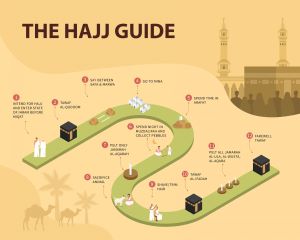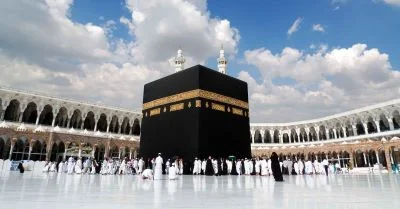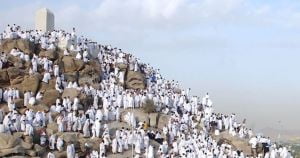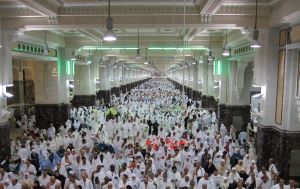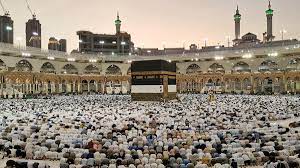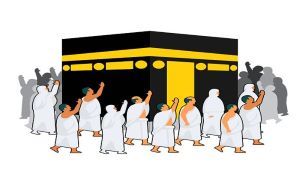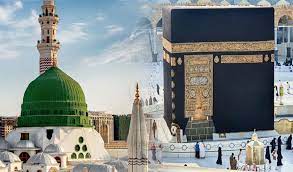How to perform Hajj
Every capable Muslim must perform the Hajj once in a lifetime.
How to perform Hajj from the moment the pilgrim lands in Saudi Arabia, until he/she departs for home.
- Every capable Muslim must perform the Hajj once in a lifetime.
It is very important for all pilgrims to know the exact procedure which must be followed before departing for Hajj. There are three ways of performing the Hajj, i.e. Ifraad (Hajj on its own), Qiraan (Hajj and Umrah together, without making a distinction between their rituals) and Tamattu’ (performing ‘Umrah first, followed by Haji).
However, this lesson will focus mainly on performing Hajj at-Tamattu”. The person who intends to perform Hajj should clip the nails, remove the pubic hairs as well as the hairs under the armpits. The person then performs ghusl (complete bathing).
The men will wear sandals, and two clean, white pieces of cloth, the izaar (lower garment) and ridaa’ (garment worn over the shoulders)
Woman must wear permissible clothing and they must not cover their hands and faces.
Upon reaching the meeqaat, the intention to perform ‘Umrah, should be made by saying:
لبيك اللهم لبيك عُمْرَةً
I am here at your service Allah,
I am here to perform ‘Umrah.
- It is forbidden for a pilgrim to pass through the meeqaat without being in ihraam.
The person continues saying the talbiyah in an audible voice, without shouting. It is not permissible for women to raise their voices; instead they should recite it softly to themselves. After reaching the Sacred Mosque (Al-Masjid Al-Haraam), the pil- grim enters and performs the tawaaf, followed by the sa’y. Thereafter the pilgrim shaves, shortens or clips the hair and comes out of a state of ihraam.
On the 8th of Dhul-Hijjah, without going back to the meeqaat, the pilgrim enters into the state of Ihraam again with the intention of performing Hajj. It is recommended to leave Makkah for Mina in the morning to spend the entire day and night (8th of Dhul-Hijjah) there. It is also recommended to perform five compulsory Salah on Mina, starting from Dhuhr Salah. Thus the pilgrim will remain on Mina until the sun rises on the Day of ‘Arafah – 9th Dhul-Hijjah. The pilgrim then leaves Mina, reciting the talbiyah and heads for Masjid ul-Namirah to pray Dhuhr and ‘Asr combined, at the time of Dhuhr. On ‘Arafah the pilgrim calls to Allah for forgiveness and mercy.
At nightfall the pilgrim heads for Muzdalifah, filled with peace and happiness.
After combining the Salah of Maghrib and ‘Ishaa, the pilgrim remains at Muzdalifah until the time of Fajr. After the Salah of Fajr he/she picks up seven pebbles that will be thrown at the Pillar of Al-‘Aqabah. The pilgrim returns to Mina while reciting the talbiyah and on his/her arrival he/she heads directly to the Pillar of Al-‘Aqabah. He/ she stones it with seven pebbles, saying
“Allah is the Greatest” الله أكبر
- while throwing each pebble. He/she remains in Mina for two or three days, slaughtering an animal as a sacrifice in any place that he/she wishes.
قال رسول الله ﷺ قدْ نَحَرْتْ هَا هُنَا ومنى كُلُّهَا مَنْحَرُ” (رواه أبو داود)
The Prophet ﷺ said: “I sacrificed here and all of Mina is a place for sacrifice [Aboo Daawood]
- The pilgrim shaves, shortens or clips the hair, though it is better to shave it. At this point he/she is released from his/her ihraam in the first phase (tahallul). The men may cover their heads and wear normal clothing.
قال رسول الله ﷺ إذا رمَى أَحَدُكُمْ جَمْرة العقبة، فقد حَلَّ لَهُ كُلُّ شَيْءٍ إِلا النَّسَاءَ (رواه مسلم)
- The pilgrim proceeds to Makkah to perform Tawaaf al-Ifaadah, which one of the pillars of the Hajj. He/she enters the masjid in a state of purity and performs tawaaf. It is not necessary for the men to expose their right shoulder or do ar-ramal. After completing the tawaaf, a pilgrim should perform two rak’ahs behind the standing place (of Ibraaheem ).Because he/she is performing At-Tamattu, he/ she goes out to the area of the sa’y and completes the seven trips of the sa’y.
After completion of the sa’y, the pilgrim is released completely from the state of ihraam and nothing is forbidden to him. As he/she has become free of the ihraam state he/shemay do whatever was forbidden to him due to the ihraam.He/she then returns to Mina and spends the night there. All three pillars are stoned on the first and second Day of Tashreeq. If the Pilgrim is in a hurry, he/she may leave Mina to go to Makkah before sunset on the second day. Some pilgrims stay for a third day which is recommended. The last part of Hajj is to perform Tawaaf ul-Wadaa’ and then the pilgrim returns home to his family. The pilgrim returns home feeling spiritually refreshed and free of sin. He/she is filled with a feeling of complete love for man and all of Allah’s creations.
The pilgrim must inspire others to prepare for the wonderful journey of Hajj. The Muslim who returns from Hajj must be a shining example to all other Muslims and has a responsibility to uphold the good morals and principles of Islam.
What we learn from the lesson:
- Every Muslim must perform Hajj once in his/her lifetime.
- The lesson focuses on Hajj At-Tamattu (Umrah and Hajj, but performing Umrah first)
- A pilgrim may not pass through the meeqaat without being in ihraam.
- Recite talbiyah while heading for Mina and ‘Arafah.
- Gather seven pebbles at Muzdalifah for stoning of Al-‘Aqabah.
- Remove ihraam and proceed to Makkah for Tawaaf ul-Ifaadah.
- Return to Mina and pelt all three pillars for two days, once per day.
- Tawaaf ul-Wadaa’ ends the pilgrimage and the pilgrim returns home.

